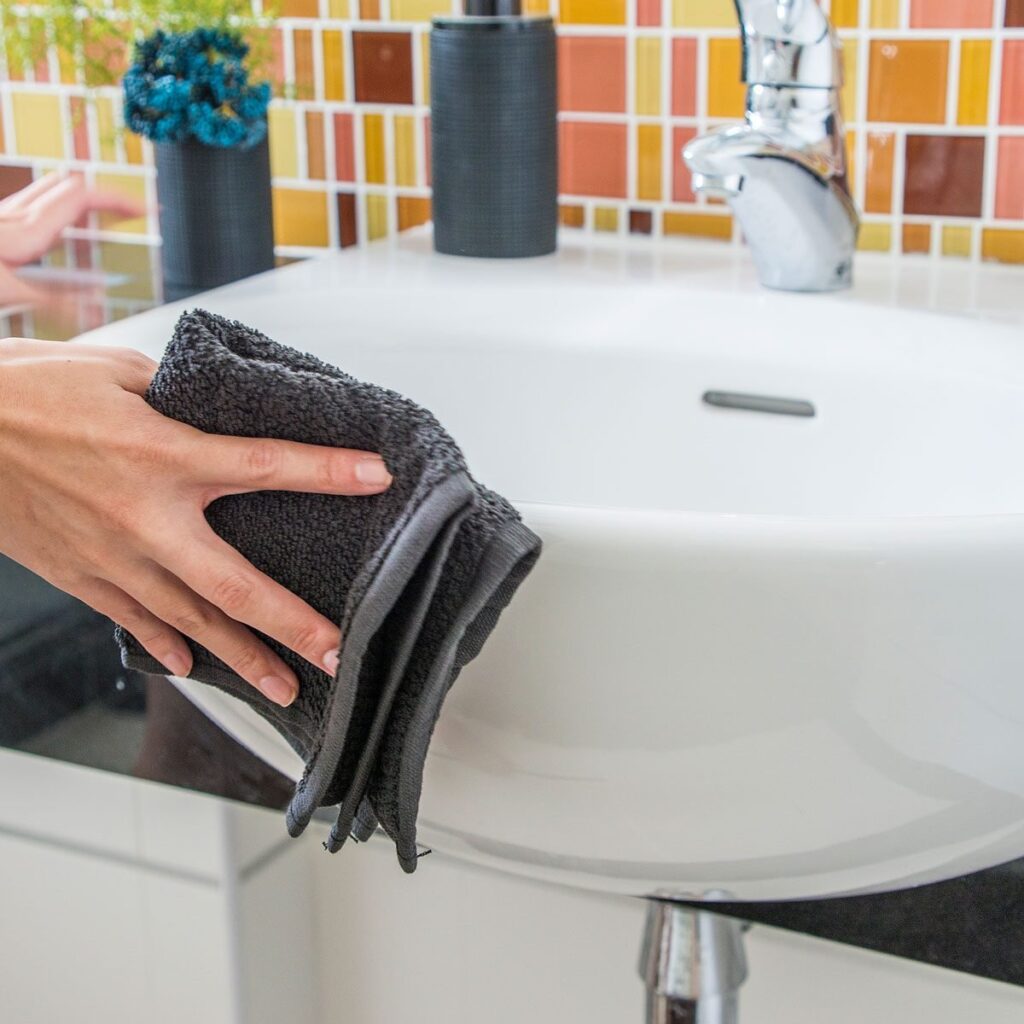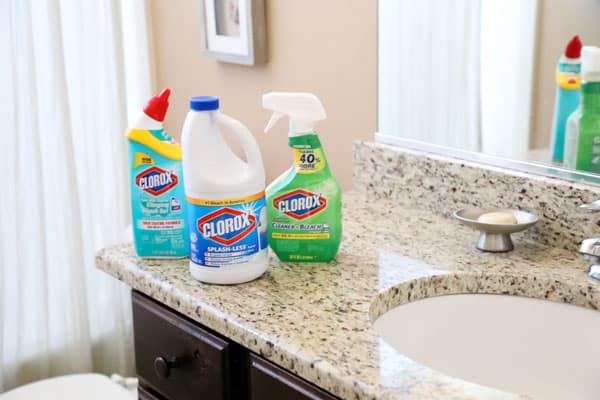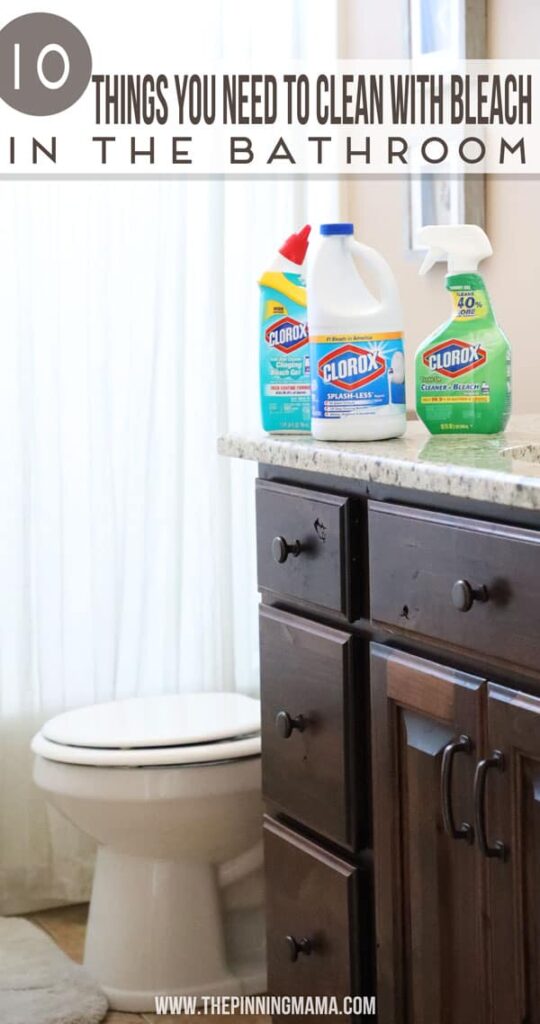So you’ve been staring at your bathroom, contemplating its cleanliness, when suddenly an age-old question pops into your head: Should you use bleach to clean your bathroom? It’s a question that has haunted mankind for generations, perplexing minds and causing heated debates in households everywhere. Today, we are here to unravel this enigma and shed some light on the great bleach debate. Brace yourselves, folks, because we are about to take you on a rollercoaster ride through the wild world of bathroom cleaning. Buckle up!
Effectiveness of Bleach in Cleaning
Killing Germs and Bacteria
Ah, good ol’ bleach. The superhero of cleaning agents, the mighty germ slayer! When it comes to killing germs and bacteria, bleach certainly knows how to make an entrance. Just a touch of this powerful potion can wipe out common household pathogens, leaving your bathroom squeaky clean and hygienic. It’s like having a microscopic SWAT team at your disposal, and who wouldn’t want that?
Removing Stains and Discoloration
If your bathroom surfaces have fallen victim to stubborn stains and unsightly discoloration, bleach is here to save the day. Armed with its magical chemical powers, bleach can work wonders on porcelain and ceramic, effortlessly removing those unseemly marks that have plagued your bathroom for far too long. Say goodbye to those embarrassing reminders of past mishaps and hello to a bathroom that’s as fresh as a daisy!
Eliminating Mold and Mildew
Mold and mildew, the invisible enemies lurking in our bathrooms. They sneakily make their homes in damp corners, leaving unsightly spots and a distinct, unpleasant odor. Thankfully, bleach possesses the ability to vanquish these stealthy intruders with ease. With a trusty bottle of bleach by our side, we can bid farewell to mold and mildew and say hello to a bathroom free from their clutches. It’s like reclaiming our own private fortress!
Potential Health Risks of Bleach
Irritation to Skin and Eyes
While bleach may have superhero-like qualities when it comes to cleaning, it’s not without its flaws. Handling bleach without caution can lead to irritated skin and eyes, turning us into temporary members of the “ouch-this-stings” club. So, if you decide to embark on a bleach cleaning adventure, make sure to wear protective gloves and avoid any accidental splashes that might make you go, “Yowza!”
Respiratory Problems
Inhaling bleach fumes can result in a not-so-pleasant experience for our respiratory system. The potent, chlorine-scented air might cause coughing, wheezing, and a general feeling of discomfort. It’s like being caught in a poorly executed magic trick, where the magician smokes us out instead of making us disappear. So keep those windows open and let some fresh air in while working with bleach.
Toxic Fumes and Chemical Reactions
Remember that high school chemistry class where mixing certain chemicals resulted in colorful and explosive reactions? Well, bleach isn’t afraid to join the party. Mixing bleach with other household cleaners, particularly those containing ammonia, can create toxic fumes that nobody wants to breathe in. It’s like the ultimate chemistry experiment gone wrong. So play it safe and keep bleach separate from its chemical BFFs.

This image is property of imagesvc.meredithcorp.io.
Compatibility with Different Surfaces
Porcelain and Ceramic
Bleach and porcelain are a match made in cleaning heaven. Porcelain surfaces, like toilets and sinks, are resilient enough to withstand the cleaning power of bleach without fear of damage or discoloration. So feel free to unleash the bleach on those porcelain surfaces and watch the magic happen!
Grout and Tiles
Grout and tiles, a notorious duo that easily fall victim to stains and grime. Luckily, bleach is more than capable of taking on this dirty duo. With a careful application and a bit of scrubbing, bleach can restore grout to its original glory and make tiles shine bright like a diamond. It’s like giving new life to these neglected bathroom essentials!
Metal Fixtures
While bleach may be a cleaning hero to many surfaces, it’s a bit of a tough love situation when it comes to metal fixtures. The potent chemicals in bleach can cause discoloration and even corrosion on certain metal surfaces. So, when aiming to brighten up those metal fixtures, it’s best to leave the bleach on the bench and explore alternative cleaning methods. It’s like a superhero reluctantly admitting they have a weakness.
Sealed and Unsealed Surfaces
Sealed surfaces, such as those coated with a protective layer, can handle the power of bleach without any issues. Unsealed surfaces, on the other hand, can be a bit more delicate. Bleach has the potential to penetrate these surfaces, causing damage and discoloration. So, be cautious when deciding to bring bleach into the unsealed surface territory. It’s like walking on eggshells, but with bleach.
Colored Surfaces
Attention, lovers of colorful bathroom decor – bleach is not your best friend. The powerful chemicals found in bleach can strip away the vibrant pigments of colored surfaces, leaving behind a faded and lackluster appearance. So, if you’re looking to maintain the integrity of your favorite colorful bathroom accessories, it’s best to seek out alternative cleaning methods. Let’s keep the rainbows intact, shall we?
Alternative Cleaning Methods
Natural Cleaners
For those who prefer to keep it au naturel, natural cleaners are an excellent alternative to bleach. These eco-friendly options harness the power of essential oils and other natural ingredients to clean and disinfect. From tea tree oil to lemon juice, nature provides a plethora of cleaning solutions that are effective, safe, and won’t leave you smelling like a swimming pool!
Vinegar and Baking Soda
Ah, the dynamic duo of cleaning – vinegar and baking soda. Together, they form a powerful cleaning force that can tackle various bathroom messes without the need for bleach. Vinegar’s acidity cuts through grime and bacteria, while baking soda’s gentle abrasiveness helps remove stains. This dynamic duo is like Batman and Robin, fighting grime one bathroom at a time.
Hydrogen Peroxide
If you’re looking for an alternative with a little extra oomph, look no further than hydrogen peroxide. This mild antiseptic and disinfectant is known for its stain-removing properties and ability to tackle mold and mildew. It’s like bleach’s cool, calm, and collected second cousin. So grab a bottle of hydrogen peroxide and let it work its magic!
Commercial Non-Bleach Cleaners
For those who prefer to leave the cleaning to the experts, commercial non-bleach cleaners are readily available on the market. These specially formulated products are designed to tackle tough bathroom stains while minimizing potential health risks. So if you’re not in the mood for a DIY cleaning adventure, trust the professionals to do the job for you. They’ve got your back!

This image is property of www.familyhandyman.com.
Best Practices for Using Bleach
Using Proper Dilution
Remember, a little goes a long way when it comes to bleach. Diluting it properly ensures effective cleaning while minimizing potential risks. Follow the instructions on the bleach bottle and don’t be tempted to go overboard. It’s like using the force responsibly – a Jedi-level skill!
Ventilation and Aerosolization
Bleach fumes are not a pleasant perfume, so make sure to ventilate your bathroom properly while using it. Open windows, turn on fans, and let that fresh air flow in. Additionally, avoid creating a bleach mist by spraying directly onto surfaces. Opt for a sponge or cloth instead, to keep those fumes in check. It’s like giving the invisible bleach cloud a one-way ticket out of your bathroom.
Protective Gear
When dealing with bleach, it’s better to be safe than sorry. Protect your skin and eyes by wearing gloves and goggles. Trust us, those stylish goggles will make you feel like a mad scientist on the brink of a major discovery. Safety first, folks!
Avoiding Mixing with Other Chemicals
Remember chemistry class? Mixing bleach with other chemicals is a big no-no. Not only can it create toxic fumes, but it can also lead to dangerous chemical reactions. So keep your bleach separate from other cleaning products and avoid creating your own science experiment. Let’s save the chemistry for another time!
Environmental Impact of Bleach
Water Contamination
While bleach might be great at killing germs, it’s not so great for the environment. When bleach-ridden water makes its way down the drain, it can contaminate our water sources. It’s like polluting our aquatic playground, and nobody likes a party pooper. So be mindful of the amount of bleach you use and consider alternative options to reduce your impact.
Impact on Aquatic Life
As bleach and its byproducts enter our waterways, they can have detrimental effects on aquatic life. Marine organisms can suffer from the toxicity of bleach, disrupting delicate ecosystems and causing long-term damage. It’s like inviting the neighborhood bully to the underwater playground. Let’s keep our aquatic friends happy and healthy!
Production and Carbon Footprint
The production of bleach involves energy-intensive processes that contribute to carbon emissions and environmental degradation. From the manufacturing of the chemicals to the packaging and transportation, bleach has a not-so-environmentally-friendly carbon footprint. It’s like leaving a giant-sized carbon footprint in the sand. So, consider greener alternatives to lighten your impact on Mother Earth.

This image is property of i0.wp.com.
Considerations for Household with Children and Pets
Child Safety and Storage
When it comes to bleach and children, it’s essential to exercise extra caution. Keep bleach out of reach and stored in a secure location, away from curious little hands. Accidental ingestion of bleach can lead to severe health complications, making for a rather unpleasant experience. Let’s keep the bleach locked away and out of harm’s way.
Animal Sensitivities and Toxicity
Our furry friends can also be sensitive to the chemicals found in bleach. Contact with bleach can irritate their skin and cause harm if ingested. For the safety and wellbeing of our beloved pets, it’s best to choose cleaning products that are specifically designed to be pet-friendly. Let’s keep the bathroom sparkling clean without causing any harm to our loyal companions.
Safer Cleaning Alternatives
For households with children and pets, it may be wise to explore safer cleaning alternatives. From vinegar and baking soda to hydrogen peroxide, there are plenty of options that can effectively clean without posing unnecessary risks. It’s like finding the perfect balance between cleanliness and safety for our little ones and furry friends.
Summary and Conclusion
After weighing the pros and cons, it’s clear that bleach is a formidable ally in the battle against bathroom grime. Its effectiveness in killing germs, removing stains, and eliminating mold and mildew is hard to beat. However, it’s important to be mindful of the potential health risks, compatibility with different surfaces, and its environmental impact.
For those who prefer a safer route, alternative methods such as natural cleaners, vinegar and baking soda, hydrogen peroxide, and commercial non-bleach cleaners offer effective options. Best practices such as proper dilution, ventilation, protective gear, and avoiding chemical mixing should always be followed when using bleach.
Ultimately, the choice of whether or not to use bleach in your cleaning arsenal comes down to personal preferences and balancing effectiveness with safety. So, put on your cleaning capes, fellow bathroom warriors, and go forth with knowledge and a sprinkle of humor to conquer those bathroom battles!

This image is property of i1.wp.com.

